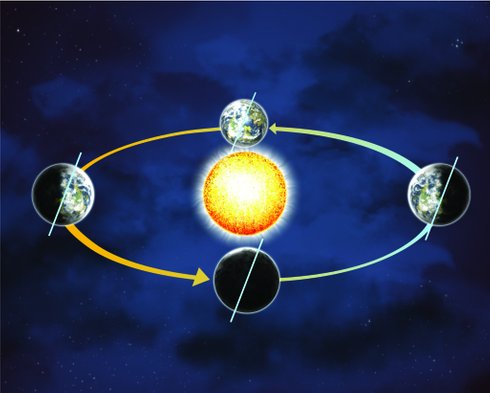(单词翻译:单击)
听力文本
This is Scientific American — 60-Second Science. I'm Christopher Intagliata.
The sun exerts an enormous and obvious influence on the Earth, with its gravity and light. But other bodies also have a small say in our affairs.
"We're not alone in the solar system, there are other planets." Dennis Kent, a geologist at Rutgers University, and Columbia's Lamont–Doherty Earth Observatory. "And as we circle the sun, those other planets and also our moon exert effects on our orbit."
In fact, planetary scientists have long hypothesized that Venus and Jupiter squeeze the Earth's orbit from circular to elliptical and back every 405,000 years. During an elliptical orbit, when the distance from the sun varies more, the differences between the seasons would be more extreme than when the orbit is virtually circular. Problem is, it's been hard to verify that this oscillation between orbit shapes exists.
But Kent and his colleagues came up with a way—by boring down into the Earth. They took a rock core from the east coast, which has excellent sediment records—good evidence of extreme seasonal variations. They compared that core with another from Arizona, embedded with zircons. The zircons contain trace amounts of uranium, which decays in a predictable way—meaning the Arizona core could thus be dated based on uranium content.

Magnetic information in both cores allowed them to be lined up—and the Arizona dates then provided a timeline for the ancient floods and droughts embedded in the east coast core.
And all that evidence confirmed the mathematical simulations: Jupiter and Venus do push us around, and thus slowly alter our orbit over hundreds of millennia. The details are in the Proceedings of the National Academy of Sciences.
Kent says the discovery also provides a new way to interpret the history of life on the planet.
"It's a clock. And so being able to have a precise chronometer we can relate things like speciation events, or dispersals of various life forms. It allows us to look at these things and try to understand what's driving them."
As for whether modern-day humans need to worry about this 405,000-year oscillation?
"This is probably pretty low down the list of things to be concerned about. How much CO2 we're putting in the atmosphere, that's of a more immediate concern." Because, despite our planetary neighbors' best efforts, our orbit has barely budged as we've observed our climate change.
Thanks for listening for Scientific American — 60-Second Science. I'm Christopher Intagliata.
参考译文
这里是科学美国人——60秒科学。我是克里斯托弗·因塔利亚塔。
太阳用其重力和光线对地球施加了巨大且明显的影响。但其他天体也对地球产生了小的影响。
“我们在太阳系中并不孤独,这里还有其他行星。”罗德斯大学和哥伦比亚大学拉蒙特-多尔蒂地球天文台的地质学家丹尼斯·肯特说到。“当地球绕太阳旋转时,其他行星和月球也会对我们的轨道产生影响。”
事实上,行星科学家长期以来一直猜测金星和木星挤压地球绕日轨道,以40.5万年为周期在“圆形—椭圆”之间循环往复。在椭圆轨道期间,当地日距离变化增大时,季节差异比轨道几乎为圆形时更加极端。问题是,我们很难证实轨道形状存在这种变动。
但肯特和同事想出了一个方法——往地球深处挖。他们在东海岸采集了一块岩心,这块岩心具有极好的沉积物记录——这是极端季节变化的充分证据。他们将这块岩心与亚利桑那州一块嵌有锆石的岩心进行了对比。锆石中含有微量铀,铀会以可预见的方式衰减——这意味着亚利桑那州的那块岩心可以依据铀含量确定形成时间。
两个岩心中的磁性信息使得它们排列整齐——亚利桑那岩心的日期为东海岸岩心中嵌入的古代洪水和干旱提供了时间线。
所有这些证据都证实了数学模拟的正确性:木星和金星确实在推着地球左右摇摆,并因此在数十亿年间缓慢调整着地球的轨道。研究具体内容发表在《美国国家科学院院刊》上。
肯特说,这一发现还为了解地球生命史提供了一种新的方式。
“这就像一个时钟。我们可以通过一个精确的时钟将各种事件关联起来,比如物种起源或各种生命形式的分散等。这使我们可以观察这些事件,并试图去了解是什么在驱动它们。”
“那现代人类是否需要担心这种以40.5万年为周期的振荡?”
“这可能是不太需要关注的事情。我们在大气中释放了多少二氧化碳,这是更迫切的问题。”因为,尽管我们周围的行星邻居尽了最大的努力,但我们的轨道在我们观察到气候变化时几乎没有变化。
谢谢大家收听科学美国人——60秒科学。我是克里斯托弗·因塔利亚塔。
译文为可可英语翻译,未经授权请勿转载!
重点讲解
重点讲解:
1. come up with 想出,提出(计划、想法等);
He thought for a while, and finally come up with a solution.
他又想了想,终于又想出了一个办法。
2. compare with 比较;对比;
We carefully compared the first report with the second.
我们仔细比较了第一份报告和第二份报告。
3. line up 使(某一批物)排列成行;对齐;
When the images line up exactly, the projectors should be fixed in place
图像完全对齐时,投影仪的位置就应该固定下来。
4. as for 至于…;
As for anything told to me in confidence, well, my lips are sealed.
至于私底下告诉我的任何事情,我会守口如瓶的。


